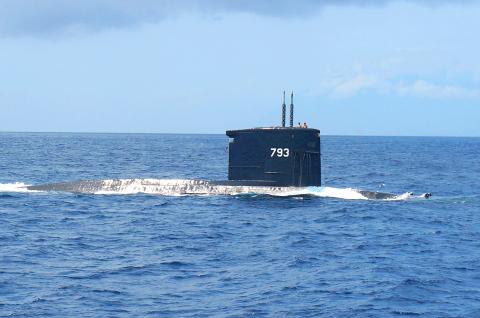The navy is to modernize the two Hai Lung-class submarines in its fleet as part of a four-year program as planned, after Netherlands-based RH Marine green-lit the program’s technical feasibility, a Ministry of National Defense official said.
Modified from the Dutch Zwaardvis-class, the Hai Lung-class subs have been in service for more than 30 years of their 35-year life span, the official told the Chinese-language Liberty Times (sister paper of the Taipei Times) on condition of anonymity.
To enhance combat capabilities and to address a shortage of parts, the navy has planned numerous improvements, including equipping the pair with long-range heavy torpedoes from the US, and upgrading their electronic warfare and combat systems, he said.

Photo: Aaron Tu, Taipei Times
The US last year approved the sale of Mark 48 torpedoes; the Chung Shan Institute of Science and Technology would be responsible for upgrading the electronic warfare and combat systems and RH Marine is to help with systems integration, the official said.
Given the subs’ small interiors and difficulty of integrating new systems with older ones, in April last year the navy sought assistance from RH Marine, he said.
The firm conducted a year-long evaluation and has completed the initial report on implementing the upgrades, the source said.
The institute is to start contracting and licensing procedures this year, while combat systems software design, equipment purchases and interface integration would begin next year, he said.
The submarines will be refitted from 2020 to 2022 to take advantage of their refurbishment cycles, he said.
The institute will furnish what equipment and components it can manufacture, while the remainder would be sourced from private companies, he said.
Ministry and institute officials approached representatives from an unnamed US defense manufacturer at the Taiwan-US Defense Business Forum held in Kaohsiung on May 10, he said.
The firm’s representatives tentatively agreed to sell the needed equipment and parts, he said.

The US government has signed defense cooperation agreements with Japan and the Philippines to boost the deterrence capabilities of countries in the first island chain, a report by the National Security Bureau (NSB) showed. The main countries on the first island chain include the two nations and Taiwan. The bureau is to present the report at a meeting of the legislature’s Foreign Affairs and National Defense Committee tomorrow. The US military has deployed Typhon missile systems to Japan’s Yamaguchi Prefecture and Zambales province in the Philippines during their joint military exercises. It has also installed NMESIS anti-ship systems in Japan’s Okinawa

‘WIN-WIN’: The Philippines, and central and eastern European countries are important potential drone cooperation partners, Minister of Foreign Affairs Lin Chia-lung said Minister of Foreign Affairs Lin Chia-lung (林佳龍) in an interview published yesterday confirmed that there are joint ventures between Taiwan and Poland in the drone industry. Lin made the remark in an exclusive interview with the Chinese-language Liberty Times (the Taipei Times’ sister paper). The government-backed Taiwan Excellence Drone International Business Opportunities Alliance and the Polish Chamber of Unmanned Systems on Wednesday last week signed a memorandum of understanding in Poland to develop a “non-China” supply chain for drones and work together on key technologies. Asked if Taiwan prioritized Poland among central and eastern European countries in drone collaboration, Lin

Renewed border fighting between Thailand and Cambodia showed no signs of abating yesterday, leaving hundreds of thousands of displaced people in both countries living in strained conditions as more flooded into temporary shelters. Reporters on the Thai side of the border heard sounds of outgoing, indirect fire yesterday. About 400,000 people have been evacuated from affected areas in Thailand and about 700 schools closed while fighting was ongoing in four border provinces, said Thai Rear Admiral Surasant Kongsiri, a spokesman for the military. Cambodia evacuated more than 127,000 villagers and closed hundreds of schools, the Thai Ministry of Defense said. Thailand’s military announced that

NO CONFIDENCE MOTION? The premier said that being toppled by the legislature for defending the Constitution would be a democratic badge of honor for him Premier Cho Jung-tai (卓榮泰) yesterday announced that the Cabinet would not countersign the amendments to the local revenue-sharing law passed by the Legislative Yuan last month. Cho said the decision not to countersign the amendments to the Act Governing the Allocation of Government Revenues and Expenditures (財政收支劃分法) was made in accordance with the Constitution. “The decision aims to safeguard our Constitution,” he said. The Constitution stipulates the president shall, in accordance with law, promulgate laws and issue mandates with the countersignature of the head of the Executive Yuan, or with the countersignatures of both the head of the Executive Yuan and ministers or